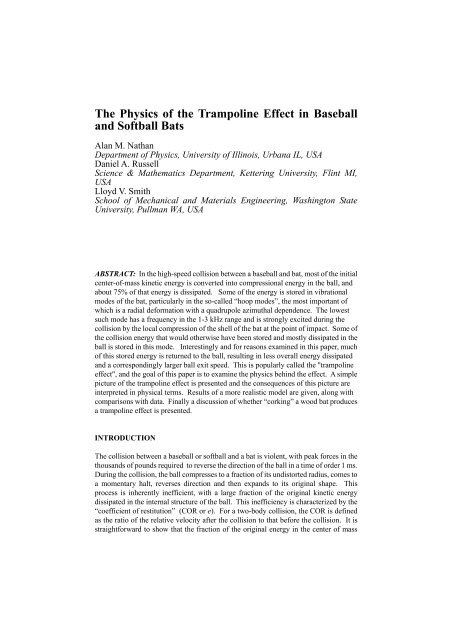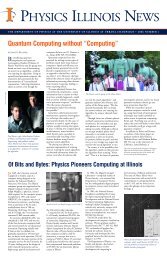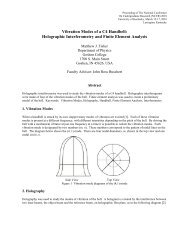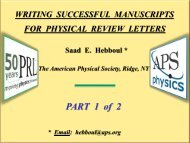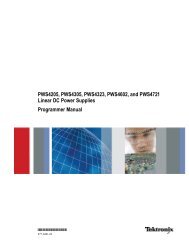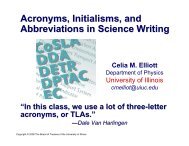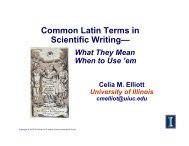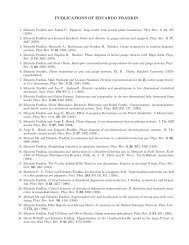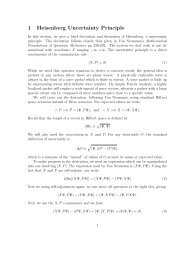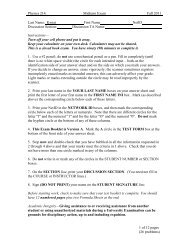The physics of the trampoline effect in baseball and softball bats
The physics of the trampoline effect in baseball and softball bats
The physics of the trampoline effect in baseball and softball bats
You also want an ePaper? Increase the reach of your titles
YUMPU automatically turns print PDFs into web optimized ePapers that Google loves.
<strong>The</strong> Physics <strong>of</strong> <strong>the</strong> Trampol<strong>in</strong>e Effect <strong>in</strong> Baseball<strong>and</strong> S<strong>of</strong>tball BatsAlan M. NathanDepartment <strong>of</strong> Physics, University <strong>of</strong> Ill<strong>in</strong>ois, Urbana IL, USADaniel A. RussellScience & Ma<strong>the</strong>matics Department, Ketter<strong>in</strong>g University, Fl<strong>in</strong>t MI,USALloyd V. SmithSchool <strong>of</strong> Mechanical <strong>and</strong> Materials Eng<strong>in</strong>eer<strong>in</strong>g, Wash<strong>in</strong>gton StateUniversity, Pullman WA, USAABSTRACT: In <strong>the</strong> high-speed collision between a <strong>baseball</strong> <strong>and</strong> bat, most <strong>of</strong> <strong>the</strong> <strong>in</strong>itialcenter-<strong>of</strong>-mass k<strong>in</strong>etic energy is converted <strong>in</strong>to compressional energy <strong>in</strong> <strong>the</strong> ball, <strong>and</strong>about 75% <strong>of</strong> that energy is dissipated. Some <strong>of</strong> <strong>the</strong> energy is stored <strong>in</strong> vibrationalmodes <strong>of</strong> <strong>the</strong> bat, particularly <strong>in</strong> <strong>the</strong> so-called “hoop modes”, <strong>the</strong> most important <strong>of</strong>which is a radial deformation with a quadrupole azimuthal dependence. <strong>The</strong> lowestsuch mode has a frequency <strong>in</strong> <strong>the</strong> 1-3 kHz range <strong>and</strong> is strongly excited dur<strong>in</strong>g <strong>the</strong>collision by <strong>the</strong> local compression <strong>of</strong> <strong>the</strong> shell <strong>of</strong> <strong>the</strong> bat at <strong>the</strong> po<strong>in</strong>t <strong>of</strong> impact. Some <strong>of</strong><strong>the</strong> collision energy that would o<strong>the</strong>rwise have been stored <strong>and</strong> mostly dissipated <strong>in</strong> <strong>the</strong>ball is stored <strong>in</strong> this mode. Interest<strong>in</strong>gly <strong>and</strong> for reasons exam<strong>in</strong>ed <strong>in</strong> this paper, much<strong>of</strong> this stored energy is returned to <strong>the</strong> ball, result<strong>in</strong>g <strong>in</strong> less overall energy dissipated<strong>and</strong> a correspond<strong>in</strong>gly larger ball exit speed. This is popularly called <strong>the</strong> "<strong>trampol<strong>in</strong>e</strong><strong>effect</strong>", <strong>and</strong> <strong>the</strong> goal <strong>of</strong> this paper is to exam<strong>in</strong>e <strong>the</strong> <strong>physics</strong> beh<strong>in</strong>d <strong>the</strong> <strong>effect</strong>. A simplepicture <strong>of</strong> <strong>the</strong> <strong>trampol<strong>in</strong>e</strong> <strong>effect</strong> is presented <strong>and</strong> <strong>the</strong> consequences <strong>of</strong> this picture are<strong>in</strong>terpreted <strong>in</strong> physical terms. Results <strong>of</strong> a more realistic model are given, along withcomparisons with data. F<strong>in</strong>ally a discussion <strong>of</strong> whe<strong>the</strong>r “cork<strong>in</strong>g” a wood bat producesa <strong>trampol<strong>in</strong>e</strong> <strong>effect</strong> is presented.INTRODUCTION<strong>The</strong> collision between a <strong>baseball</strong> or s<strong>of</strong>tball <strong>and</strong> a bat is violent, with peak forces <strong>in</strong> <strong>the</strong>thous<strong>and</strong>s <strong>of</strong> pounds required to reverse <strong>the</strong> direction <strong>of</strong> <strong>the</strong> ball <strong>in</strong> a time <strong>of</strong> order 1 ms.Dur<strong>in</strong>g <strong>the</strong> collision, <strong>the</strong> ball compresses to a fraction <strong>of</strong> its undistorted radius, comes toa momentary halt, reverses direction <strong>and</strong> <strong>the</strong>n exp<strong>and</strong>s to its orig<strong>in</strong>al shape. Thisprocess is <strong>in</strong>herently <strong>in</strong>efficient, with a large fraction <strong>of</strong> <strong>the</strong> orig<strong>in</strong>al k<strong>in</strong>etic energydissipated <strong>in</strong> <strong>the</strong> <strong>in</strong>ternal structure <strong>of</strong> <strong>the</strong> ball. This <strong>in</strong>efficiency is characterized by <strong>the</strong>“coefficient <strong>of</strong> restitution” (COR or e). For a two-body collision, <strong>the</strong> COR is def<strong>in</strong>edas <strong>the</strong> ratio <strong>of</strong> <strong>the</strong> relative velocity after <strong>the</strong> collision to that before <strong>the</strong> collision. It isstraightforward to show that <strong>the</strong> fraction <strong>of</strong> <strong>the</strong> orig<strong>in</strong>al energy <strong>in</strong> <strong>the</strong> center <strong>of</strong> mass
(CM) frame that is dissipated <strong>in</strong> <strong>the</strong> collision is 1-e 2 . For a perfectly elastic collision,no energy is dissipated, <strong>the</strong> two bodies recede with <strong>the</strong> <strong>in</strong>itial relative velocity, <strong>and</strong> e=1.For a perfectly <strong>in</strong>elastic collision, <strong>the</strong> two bodies stick toge<strong>the</strong>r, all <strong>the</strong> <strong>in</strong>itial CMenergy is dissipated, <strong>and</strong> e=0.<strong>The</strong> COR is actually a jo<strong>in</strong>t property <strong>of</strong> <strong>the</strong> two collid<strong>in</strong>g bodies. Never<strong>the</strong>less, it iscommon to refer to <strong>the</strong> “COR <strong>of</strong> <strong>the</strong> ball”, denoted here<strong>in</strong> by <strong>the</strong> symbol e 0 , which is <strong>the</strong>COR when <strong>the</strong> ball collides with a massive rigid wall. In such a collision, all <strong>of</strong> <strong>the</strong>energy losses come from dissipation <strong>in</strong> <strong>the</strong> ball. For a <strong>baseball</strong> or s<strong>of</strong>tball at speedstypical <strong>of</strong> <strong>the</strong> game, e 0 is about 0.5, so that 75% <strong>of</strong> <strong>the</strong> <strong>in</strong>itial energy stored <strong>in</strong> <strong>the</strong> ball isdissipated. For <strong>the</strong> collision <strong>of</strong> a <strong>baseball</strong> with a bat, e is generally different from e 0 dueto <strong>the</strong> flexibility <strong>of</strong> <strong>the</strong> bat. As a result <strong>the</strong> ball <strong>and</strong> <strong>the</strong> bat mutually compress eacho<strong>the</strong>r dur<strong>in</strong>g <strong>the</strong> collision, so that some <strong>of</strong> <strong>the</strong> CM energy that might o<strong>the</strong>rwise havegone <strong>in</strong>to compress<strong>in</strong>g <strong>the</strong> ball <strong>in</strong>stead goes <strong>in</strong>to compress<strong>in</strong>g <strong>the</strong> bat. <strong>The</strong>refore lessenergy gets stored <strong>and</strong> dissipated <strong>in</strong> <strong>the</strong> ball. Whe<strong>the</strong>r <strong>the</strong> COR <strong>in</strong>creases or decreasesrelative to e 0 depends on how <strong>effect</strong>ively <strong>the</strong> compressional energy stored <strong>in</strong> <strong>the</strong> bat isreturned to <strong>the</strong> ball. For solid wood <strong>bats</strong>, <strong>the</strong> energy stored <strong>in</strong> <strong>the</strong> bat is not <strong>effect</strong>ivelyreturned to <strong>the</strong> ball but <strong>in</strong>stead appears as low-frequency bend<strong>in</strong>g vibrations. <strong>The</strong>refore,e never exceeds e 0 , <strong>and</strong> for collisions far from <strong>the</strong> nodes <strong>of</strong> <strong>the</strong> lowest few vibrations, eis considerably less than e 0 (Nathan, 2000). For hollow <strong>bats</strong>, such as <strong>the</strong> commonlyused alum<strong>in</strong>um bat, energy is also stored <strong>in</strong> <strong>the</strong> so-called hoop modes, whichcorrespond to a compression <strong>of</strong> <strong>the</strong> th<strong>in</strong> shell. For reasons that will be exam<strong>in</strong>ed <strong>in</strong> thispaper, <strong>the</strong> energy stored <strong>in</strong> <strong>the</strong> hoop modes is efficiently returned to <strong>the</strong> ball, result<strong>in</strong>g <strong>in</strong>a COR which is larger than e 0 . This phenomenon is commonly referred to as <strong>the</strong><strong>trampol<strong>in</strong>e</strong> <strong>effect</strong>. <strong>The</strong> question as to why <strong>the</strong> hoop modes are <strong>effect</strong>ive <strong>and</strong> <strong>the</strong>bend<strong>in</strong>g modes are not <strong>effect</strong>ive at return<strong>in</strong>g stored energy to <strong>the</strong> ball is one that will beaddressed <strong>in</strong> this paper.A SIMPLE PHYSICAL PICTURE<strong>The</strong> ball-bat collision is a complicated problemthat is nei<strong>the</strong>r easy to solve from first pr<strong>in</strong>ciplesnor particularly illum<strong>in</strong>at<strong>in</strong>g to do so .<strong>The</strong>refore a toy model is proposed which,while highly simplified, captures <strong>the</strong> essential<strong>physics</strong> <strong>of</strong> <strong>the</strong> <strong>trampol<strong>in</strong>e</strong> <strong>effect</strong>. <strong>The</strong> model,shown schematically <strong>in</strong> Fig. 1, is similar to thatconsidered earlier for tennis (Cross, 2000) or<strong>baseball</strong> (Naruo <strong>and</strong> Sato, 1997) <strong>and</strong> consists <strong>of</strong>represent<strong>in</strong>g <strong>the</strong> ball <strong>and</strong> bat as l<strong>in</strong>ear spr<strong>in</strong>gsthat can mutually compress each o<strong>the</strong>r. <strong>The</strong>Figure 1 Mass-spr<strong>in</strong>g model for<strong>the</strong> ball-bat collision.ball consists <strong>of</strong> a mass m attached to a damped spr<strong>in</strong>g <strong>of</strong> force constant k ball. , with <strong>the</strong>o<strong>the</strong>r end <strong>of</strong> <strong>the</strong> spr<strong>in</strong>g free. <strong>The</strong> bat consists <strong>of</strong> a mass M attached to an undampedspr<strong>in</strong>g <strong>of</strong> force constant k bat , with <strong>the</strong> opposite side <strong>of</strong> <strong>the</strong> spr<strong>in</strong>g attached to a massivewall. <strong>The</strong> collision consists <strong>of</strong> <strong>the</strong> free end <strong>of</strong> <strong>the</strong> ball spr<strong>in</strong>g, <strong>in</strong>itially mov<strong>in</strong>g withspeed v o , collid<strong>in</strong>g with <strong>the</strong> mass M, <strong>in</strong>itially at rest. <strong>The</strong> collision is trackednumerically until <strong>the</strong> ball spr<strong>in</strong>g <strong>and</strong> bat mass separate, whereupon <strong>the</strong> ball has a f<strong>in</strong>alspeed v. <strong>The</strong> COR is <strong>the</strong> ratio v/ v o . In this model, <strong>the</strong> bat has only a s<strong>in</strong>gle degree <strong>of</strong>
freedom correspond<strong>in</strong>g to <strong>the</strong> vibration <strong>of</strong> M on <strong>the</strong> bat spr<strong>in</strong>g. All o<strong>the</strong>r degrees <strong>of</strong>freedom, such as <strong>the</strong> rigid body motion <strong>and</strong> o<strong>the</strong>r vibrational modes <strong>of</strong> <strong>the</strong> bat, areignored; while <strong>the</strong>y may be important to <strong>the</strong> underst<strong>and</strong><strong>in</strong>g <strong>of</strong> how a real bat works,<strong>the</strong>y are not essential to our underst<strong>and</strong><strong>in</strong>g <strong>of</strong> <strong>the</strong> <strong>trampol<strong>in</strong>e</strong> <strong>effect</strong>. This model isnearly identical to that used earlier (Nathan, 2000) to characterize <strong>the</strong> bend<strong>in</strong>gvibrations <strong>of</strong> <strong>the</strong> bat, except that <strong>in</strong> <strong>the</strong> latter case <strong>the</strong>re was no dissipation <strong>in</strong> <strong>the</strong> ball.<strong>The</strong> three parameters describ<strong>in</strong>g <strong>the</strong> ball (m, k ball, <strong>and</strong> damp<strong>in</strong>g constant) are chosento reproduce <strong>the</strong> known mass (5.2 oz), ball-wall collision time (~0.6 ms), <strong>and</strong> e 0 (0.5)for a <strong>baseball</strong> (Adair, 2002). <strong>The</strong> dependence <strong>of</strong> <strong>the</strong> COR on <strong>the</strong> two bat parameters M<strong>and</strong> k bat is <strong>in</strong>vestigated. Actually it is more physically mean<strong>in</strong>gful to <strong>in</strong>vestigate <strong>the</strong>dependence on two related factors. One <strong>of</strong> <strong>the</strong>se is <strong>the</strong> ratio <strong>of</strong> spr<strong>in</strong>g constantsr k =k bat /k ball ; <strong>the</strong> o<strong>the</strong>r is <strong>the</strong> product fτ, where 2π f = kbat/ M is <strong>the</strong> natural vibrationalfrequency <strong>of</strong> <strong>the</strong> bat spr<strong>in</strong>g <strong>and</strong> τ is <strong>the</strong> collision time, <strong>the</strong> latter determ<strong>in</strong>ed primarilyby <strong>the</strong> ball parameters. For fτ >1, r k is roughly proportional to <strong>the</strong> ratio <strong>of</strong> <strong>in</strong>itial energystored <strong>in</strong> <strong>the</strong> compression <strong>of</strong> <strong>the</strong> ball to that stored <strong>in</strong> <strong>the</strong> compression <strong>of</strong> <strong>the</strong> bat;<strong>the</strong>refore it is expected to play acrucial role <strong>in</strong> <strong>the</strong> <strong>trampol<strong>in</strong>e</strong><strong>effect</strong>. On <strong>the</strong> o<strong>the</strong>r h<strong>and</strong>, fτdeterm<strong>in</strong>es <strong>the</strong> fraction <strong>of</strong> <strong>in</strong>itialenergy that is transferred to <strong>the</strong>vibrational mode <strong>of</strong> <strong>the</strong> bat, aswill be seen by <strong>the</strong> explicitcalculations described below.<strong>The</strong> <strong>effect</strong>ive bat mass M is<strong>in</strong>itially set to be four times <strong>the</strong>ball mass (20.8 oz), <strong>and</strong> <strong>the</strong>dependence <strong>of</strong> <strong>the</strong> COR on r k is<strong>in</strong>vestigated. <strong>The</strong> results aresummarized <strong>in</strong> Fig. 2, whichshows both <strong>the</strong> COR <strong>and</strong> how <strong>the</strong>f<strong>in</strong>al energy is partitioned.It is both <strong>in</strong>terest<strong>in</strong>g <strong>and</strong><strong>in</strong>structive to discuss <strong>in</strong>itially <strong>the</strong>two limit<strong>in</strong>g cases (Nathan, 2000).For r k >>1 <strong>and</strong> fτ >1, <strong>the</strong> bat lookscompletely rigid <strong>and</strong> <strong>the</strong>refore<strong>in</strong>f<strong>in</strong>itely massive dur<strong>in</strong>g <strong>the</strong>collision, so that <strong>the</strong> ball bouncesfrom it as it would bounce fromany massive rigid object; i.e., wi<strong>the</strong>=e 0 , with 25% <strong>of</strong> <strong>the</strong> <strong>in</strong>itialenergy go<strong>in</strong>g to <strong>the</strong> rebound<strong>in</strong>gball, with 75% <strong>of</strong> <strong>the</strong> <strong>in</strong>itialCOR0.600.500.400.300.50.200 25 50 75 100 0energy fraction0.800.600.400.20CORdissipationvibrations0.00 25 50 75 100energy dissipated <strong>in</strong> <strong>the</strong> ball, <strong>and</strong> with no energy transferred to <strong>the</strong> bat. This regime isdenoted as <strong>the</strong> “strong coupl<strong>in</strong>g” limit, because <strong>the</strong> mass M is <strong>effect</strong>ively rigidlyattached to <strong>the</strong> wall. For r k
mass so quickly compared with <strong>the</strong> vibrational period <strong>of</strong> <strong>the</strong> bat that <strong>the</strong> mass has notime to recoil dur<strong>in</strong>g <strong>the</strong> collision, so <strong>the</strong> ball bounces from an essentially free object <strong>of</strong>mass M. This <strong>in</strong>terpretation is <strong>in</strong> complete accord with <strong>the</strong> numerical results for <strong>the</strong>COR as well as <strong>the</strong> partition<strong>in</strong>g <strong>of</strong> <strong>the</strong> <strong>in</strong>itial energy <strong>in</strong>to k<strong>in</strong>etic energy <strong>of</strong> <strong>the</strong>rebound<strong>in</strong>g ball, energy dissipated <strong>in</strong> <strong>the</strong> ball, <strong>and</strong> energy transferred to <strong>the</strong> bat, <strong>the</strong>latter <strong>in</strong> <strong>the</strong> form <strong>of</strong> vibrations. This regime is denoted as <strong>the</strong> “quasi-free” limit,because <strong>the</strong> bat mass is essentially free dur<strong>in</strong>g <strong>the</strong> collision. Note that for <strong>the</strong> particularmass chosen, <strong>the</strong> COR <strong>in</strong> <strong>the</strong> quasi-free limit is actually less than e 0 , a fact that makessense physically: a ball rebounds from a f<strong>in</strong>ite-mass object with less speed than froman <strong>in</strong>f<strong>in</strong>ite-mass object.Start<strong>in</strong>g from <strong>the</strong> strong coupl<strong>in</strong>g limit, as r k is reduced with M fixed, more energygets stored <strong>in</strong> <strong>the</strong> bat spr<strong>in</strong>g, less energy gets stored (<strong>and</strong> dissipated) <strong>in</strong> <strong>the</strong> ball spr<strong>in</strong>g,<strong>and</strong> <strong>the</strong> COR rises; for <strong>the</strong> ra<strong>the</strong>r large value <strong>of</strong> M chosen here, <strong>the</strong> rise is only modest<strong>and</strong> not typical <strong>of</strong> alum<strong>in</strong>um <strong>bats</strong>. <strong>The</strong> energy plots are consistent with this picture as<strong>the</strong>y demonstrate that as r k is reduced, <strong>the</strong> k<strong>in</strong>etic energy fraction <strong>of</strong> <strong>the</strong> rebound<strong>in</strong>g ball<strong>in</strong>creases, <strong>and</strong> <strong>the</strong> fraction <strong>of</strong> energy dissipated <strong>in</strong> <strong>the</strong> ball decreases. As long as <strong>the</strong>collision time is longer than ~1/f, no net energy is transferred to <strong>the</strong> bat. <strong>The</strong> physicalpicture is that <strong>the</strong> ball adiabatically pushes on <strong>the</strong> bat spr<strong>in</strong>g, <strong>in</strong>itially compress<strong>in</strong>g it,<strong>the</strong>n releas<strong>in</strong>g it, on a time scale long compared with <strong>the</strong> vibrational period <strong>of</strong> <strong>the</strong> spr<strong>in</strong>g.Under such conditions, all <strong>of</strong> <strong>the</strong> compressional energy <strong>of</strong> <strong>the</strong> bat is returned to <strong>the</strong> ball<strong>and</strong> none rema<strong>in</strong>s <strong>in</strong> <strong>the</strong> bat. With fur<strong>the</strong>r reduction <strong>in</strong> r k , <strong>and</strong> a consequent reduction <strong>in</strong>fτ, a grow<strong>in</strong>g fraction <strong>of</strong> <strong>the</strong> energy stored <strong>in</strong> <strong>the</strong> bat rema<strong>in</strong>s <strong>in</strong> <strong>the</strong> bat after <strong>the</strong> collision.As a result, <strong>the</strong> COR curve does not cont<strong>in</strong>ue to grow to unity, as it would <strong>in</strong> <strong>the</strong>absence <strong>of</strong> energy transferred to <strong>the</strong> bat. Instead it reaches a peak, <strong>the</strong>n subsequentlystarts to fall because <strong>the</strong> energy transferred to <strong>the</strong> bat grows rapidly as fτ
consist<strong>in</strong>g <strong>of</strong> a th<strong>in</strong>, deformable, butnearly massless membrane, forwhich <strong>the</strong> COR is nearly unity<strong>in</strong>dependent <strong>of</strong> e 0 . Indeed, acompletely dead ball with e 0 =0would be <strong>in</strong>dist<strong>in</strong>guishable from asuperball with e 0 ≅1 when bouncedfrom such a membrane (Adair,2002).Some practical consequencesfollow from our simple picture:• While on <strong>the</strong> ris<strong>in</strong>g part <strong>of</strong> <strong>the</strong>COR-vs.-r k curve, <strong>the</strong> COR canbe <strong>in</strong>creased with ei<strong>the</strong>r a s<strong>of</strong>terbat (k bat smaller) or a harder ball(k ball larger). <strong>The</strong> <strong>effect</strong> <strong>of</strong>s<strong>of</strong>tball compression on batperformance is discussed at thisCOR0.800.700.600.500.400.300.200 10 20 30 40 50Figure 4. COR vs .r k for M=5 (solid), 10(dotted), 15 (dashed), <strong>and</strong> 20 (dash-dotted)oz. <strong>The</strong> anomalous behavior for M=10arises because <strong>of</strong> multiple collisions.conference (Duris <strong>and</strong> Smith, 2004).• <strong>The</strong> ratio e/e 0 , <strong>of</strong>ten referred to as <strong>the</strong> Bat Performance Factor or BPF (Nathan,2003), is not <strong>in</strong>dependent <strong>of</strong> e 0 but ra<strong>the</strong>r decreases with <strong>in</strong>creas<strong>in</strong>g e 0 .. Indeed <strong>the</strong>above example <strong>of</strong> <strong>the</strong> superball <strong>and</strong> dead ball is a dramatic, albeit extreme,demonstration <strong>of</strong> this po<strong>in</strong>t: <strong>The</strong> BPF is 1 for <strong>the</strong> superball <strong>and</strong> <strong>in</strong>f<strong>in</strong>ite for <strong>the</strong> deadball. This conclusion is contrary to <strong>the</strong> commonly held belief that <strong>the</strong> BPFnormalizes out <strong>the</strong> <strong>effect</strong> <strong>of</strong> <strong>the</strong> ball COR <strong>and</strong> so represents a bat property that is<strong>in</strong>dependent <strong>of</strong> e 0 . Our conclusion is <strong>in</strong> accord with recent unpublished data takenat <strong>the</strong> Sports Science Laboratory (SSL) at Wash<strong>in</strong>gton State University.• A <strong>baseball</strong> is almost surely a nonl<strong>in</strong>ear spr<strong>in</strong>g (Adair, 2002), with <strong>the</strong> <strong>effect</strong>ivespr<strong>in</strong>g constant <strong>in</strong>creas<strong>in</strong>g <strong>and</strong> e 0 decreas<strong>in</strong>g with <strong>in</strong>cident speed. As aconsequence, <strong>the</strong> BPF grows with higher <strong>in</strong>cident speed, <strong>in</strong> agreement with datataken at <strong>the</strong> SSL.• For r k >>1, <strong>the</strong> collision time depends only on <strong>the</strong> ball mass-spr<strong>in</strong>g system.However, as r k is reduced from this limit, <strong>the</strong> <strong>effect</strong>ive spr<strong>in</strong>g constant is reduced as<strong>the</strong> bat spr<strong>in</strong>g also compresses, result<strong>in</strong>g <strong>in</strong> a somewhat longer collision time.<strong>The</strong>refore a weak correlation is expected between e <strong>and</strong> collision time, a featurethat is exploited <strong>in</strong> <strong>the</strong> pendulum test that is used to characterize <strong>the</strong> performance<strong>of</strong> golf drivers (USGA, 2003).• For given ball parameters, <strong>the</strong> COR depends on both vibration parameters, M <strong>and</strong>k bat . Because each parameter can be <strong>in</strong>dependently adjusted, <strong>the</strong> COR is notexpected to be a unique function <strong>of</strong> <strong>the</strong> <strong>trampol<strong>in</strong>e</strong> frequency alone. This issue isaddressed <strong>in</strong> a contribution to <strong>the</strong>se proceed<strong>in</strong>gs (Russell, 2004).BEYOND THE SIMPLE PICTUREAn improvement to <strong>the</strong> simple picture is sought, us<strong>in</strong>g as a start<strong>in</strong>g po<strong>in</strong>t <strong>the</strong> model <strong>of</strong><strong>the</strong> ball-bat collision that was previously developed to treat <strong>the</strong> bend<strong>in</strong>g modes <strong>of</strong> solidwood <strong>bats</strong> (Nathan, 2000). For hollow <strong>bats</strong>, <strong>the</strong>re are additional “hoop” modes due tork
<strong>the</strong> deformation <strong>of</strong> <strong>the</strong> th<strong>in</strong> shell.<strong>The</strong> lowest hoop mode is aquadrupole-type deformation with4 nodes <strong>in</strong> <strong>the</strong> azimuthal direction<strong>and</strong> a frequency typically <strong>in</strong> <strong>the</strong>range 1000-3000 Hz (Russell,2004). From th<strong>in</strong>-shell <strong>the</strong>ory, <strong>the</strong>stiffness <strong>of</strong> a shell for such adeformation scales with (t/R) 3 ,where t <strong>and</strong> R are <strong>the</strong> shellthickness <strong>and</strong> radius, respectively.<strong>The</strong>refore, <strong>the</strong> mode is expected tohave appreciable amplitude only <strong>in</strong><strong>the</strong> fat part <strong>of</strong> <strong>the</strong> bat, <strong>in</strong> agreementwith recent experiments (Russell,2004). <strong>The</strong> previous model ismodified by add<strong>in</strong>g a s<strong>in</strong>gle hoopCOR0.600.560.520.480.440.405 6 7 8 9 10 11distance from barrel (<strong>in</strong>ches)Figure 5. Calculated (curves) <strong>and</strong> measured(po<strong>in</strong>ts) COR vs. impact location.mode, whose properties (mass, modal shape, <strong>and</strong> spr<strong>in</strong>g constant) are derived fromexperimental data ra<strong>the</strong>r than from a first-pr<strong>in</strong>ciples calculation. This revised model is<strong>the</strong>n used to study <strong>the</strong> collision between a s<strong>of</strong>tball <strong>and</strong> a particular s<strong>of</strong>tball bat, whosemodal <strong>and</strong> collision properties have been studied experimentally. <strong>The</strong> result<strong>in</strong>g COR isplotted as a function <strong>of</strong> impact location <strong>in</strong> Fig. 5, along with experimental data taken at<strong>the</strong> SSL. <strong>The</strong> solid curve, represent<strong>in</strong>g <strong>the</strong> full calculation, faithfully accounts for <strong>the</strong>overall size <strong>and</strong> <strong>the</strong> spatial dependence <strong>of</strong> <strong>the</strong> COR, although a relative shift by ~1/2”would improve <strong>the</strong> agreement. <strong>The</strong> dashed curve is a calculation that elim<strong>in</strong>ates <strong>the</strong>third bend<strong>in</strong>g mode, which has a frequency <strong>of</strong> 1174 Hz. Interest<strong>in</strong>gly, elim<strong>in</strong>at<strong>in</strong>g thismode decreases <strong>the</strong> COR, suggest<strong>in</strong>g that this mode contributes to <strong>the</strong> <strong>trampol<strong>in</strong>e</strong> <strong>effect</strong>.<strong>The</strong> frequency <strong>of</strong> <strong>the</strong> mode is nearly optimum, given <strong>the</strong> collision time <strong>of</strong>approximately 1 ms. Lower frequency modes are net dissipaters <strong>of</strong> energy whereashigher frequency modes are too stiff to contribute to <strong>the</strong> <strong>trampol<strong>in</strong>e</strong> <strong>effect</strong>. Closer<strong>in</strong>spection shows that this mode has an ant<strong>in</strong>ode 10” from <strong>the</strong> barrel end, close to <strong>the</strong>“sweet spot zone,” def<strong>in</strong>ed as <strong>the</strong> region <strong>of</strong> <strong>the</strong> maximum <strong>of</strong> <strong>the</strong> COR curve. <strong>The</strong>seobservations suggest that improved performance <strong>of</strong> this bat might be obta<strong>in</strong>ed byredistribut<strong>in</strong>g <strong>the</strong> mass <strong>in</strong> order to move <strong>the</strong> ant<strong>in</strong>ode <strong>of</strong> <strong>the</strong> third bend<strong>in</strong>g mode closerto <strong>the</strong> sweet spot zoneDOES A CORKED BAT HAVE A TRAMPOLINE EFFECT?A corked bat is a wood bat <strong>in</strong> which a cyl<strong>in</strong>drical cavity is drilled axially <strong>in</strong>to <strong>the</strong> barrel<strong>of</strong> <strong>the</strong> bat. Typically <strong>the</strong> diameter <strong>of</strong> <strong>the</strong> cavity is ~1” <strong>and</strong> <strong>the</strong> length ~l0”. Often <strong>the</strong>cavity is filled with a light <strong>in</strong>ert material, such as cork—hence, cork<strong>in</strong>g. By remov<strong>in</strong>gweight from <strong>the</strong> barrel region, <strong>the</strong> batter can achieve a higher sw<strong>in</strong>g speed <strong>and</strong> betterbat control. This <strong>in</strong>creased sw<strong>in</strong>g speed is at least partially compensated by a less<strong>effect</strong>ive collision due to <strong>the</strong> lower barrel weight. Some batters claim that <strong>the</strong> emptycavity gives rise to a <strong>trampol<strong>in</strong>e</strong> <strong>effect</strong>, much like <strong>in</strong> hollow metal <strong>bats</strong>. Given <strong>the</strong> steepdependence <strong>of</strong> <strong>the</strong> hoop spr<strong>in</strong>g constant on wall thickness, this claim seems highlyunlikely. For example, <strong>the</strong> thickness <strong>of</strong> a typical alum<strong>in</strong>um bat is only about 0.1”
whereas <strong>the</strong> wall thickness <strong>of</strong> a hollowed-out wood bat is perhaps 7 times larger. Inorder to <strong>in</strong>vestigate this question experimentally, <strong>the</strong> SSL facility was used to fire a<strong>baseball</strong> at 110 mph <strong>in</strong>to <strong>the</strong> barrel <strong>of</strong> a bat that was <strong>in</strong>itially at rest but free to pivotabout <strong>the</strong> h<strong>and</strong>le. <strong>The</strong> <strong>in</strong>com<strong>in</strong>g <strong>and</strong> outgo<strong>in</strong>g speeds <strong>of</strong> <strong>the</strong> ball were measured whichwere used along with k<strong>in</strong>ematic formulas (Nathan, 2003) to determ<strong>in</strong>e <strong>the</strong> COR. As<strong>in</strong>gle <strong>baseball</strong> <strong>and</strong> st<strong>and</strong>ard wood batwere used. Initially <strong>the</strong> unmodified batwas impacted. <strong>The</strong>n a cavity was bored<strong>in</strong>to <strong>the</strong> bat <strong>and</strong> <strong>the</strong> hollowed-out batwas impacted. F<strong>in</strong>ally, <strong>the</strong> cavity wasfilled with cork <strong>and</strong> <strong>the</strong> corked bat wasimpacted. A “monitor bat” was usedthroughout <strong>the</strong> experiment to verify that<strong>the</strong> properties <strong>of</strong> <strong>the</strong> <strong>baseball</strong> had notchanged as <strong>the</strong> result <strong>of</strong> repeatedimpacts. <strong>The</strong> results, presented <strong>in</strong> Fig. 6,show no appreciable difference among<strong>the</strong> three <strong>bats</strong>. It is concluded that <strong>the</strong>reis no measurable <strong>trampol<strong>in</strong>e</strong> <strong>effect</strong>from a hollowed or corked bat.SUMMARYCOR0.4950.4900.4850.4800.475unmodifiedhollowedcorkedFigure 6. Measured COR for an unmodified,hollowed, <strong>and</strong> corked wood bat.<strong>The</strong> <strong>physics</strong> <strong>of</strong> <strong>the</strong> <strong>trampol<strong>in</strong>e</strong> <strong>effect</strong> <strong>in</strong> <strong>baseball</strong> <strong>and</strong> s<strong>of</strong>tball <strong>bats</strong> has been <strong>in</strong>vestigated<strong>in</strong> <strong>the</strong> context <strong>of</strong> simple models <strong>of</strong> <strong>the</strong> ball-bat collision. <strong>The</strong> model provides excellentagreement with a variety <strong>of</strong> qualitatitve phenomena related to <strong>the</strong> performance <strong>of</strong> <strong>bats</strong>.No experimental evidence is found for a <strong>trampol<strong>in</strong>e</strong> <strong>effect</strong> <strong>in</strong> hollowed or corked wood<strong>bats</strong>.REFERENCESAdair, R. K. (2002) <strong>The</strong> Physics <strong>of</strong> Baseball, 3 rd edn., HarperColl<strong>in</strong>s, New York.Cross, Rod (2000), <strong>The</strong> coefficient <strong>of</strong> restitution for collisions <strong>of</strong> happy balls, unhappyBalls, <strong>and</strong> tennis balls. Am. J. Phys., 68, 1025-1031.Duras, J. <strong>and</strong> L. Smith (2004). Evaluat<strong>in</strong>g test methods used to characterize s<strong>of</strong>tballs.Proceed<strong>in</strong>gs <strong>of</strong> ISEA2004.Nathan, A. M. (2000) Dynamics <strong>of</strong> <strong>the</strong> <strong>baseball</strong>-bat collision. Am. J. Phys., 68,979-990.Nathan, A. M. (2003) Characteriz<strong>in</strong>g <strong>the</strong> performance <strong>of</strong> <strong>baseball</strong> <strong>bats</strong>. Am. J. Phys., 71,134-143.Naruo, T. <strong>and</strong> F. Sato (1997) Performance <strong>of</strong> a <strong>baseball</strong> bat. Proc. 5 th Japan Int.SAMPE Symposium, 1311-1316.Russell, D. A. (2004) Hoop frequency as a predictor <strong>of</strong> performance for s<strong>of</strong>tball <strong>bats</strong>.Proceed<strong>in</strong>gs <strong>of</strong> ISEA2004.USGA (2004). Although a technical report is not publicly available, a brief descriptioncan be found at <strong>the</strong> web site www.usga.org/test_center/method_measurement.html


